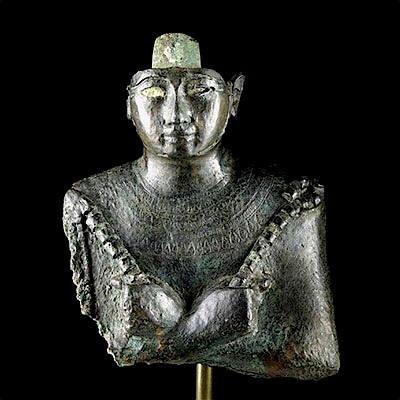Published Etruscan Bronze Montefortino Helmet
Lot 40b
About Seller
Artemis Fine Arts
686 S Taylor Ave, Ste 106
Louisville, CO 80027
United States
Selling antiquities, ancient and ethnographic art online since 1993, Artemis Gallery specializes in Classical Antiquities (Egyptian, Greek, Roman, Near Eastern), Asian, Pre-Columbian, African / Tribal / Oceanographic art. Our extensive inventory includes pottery, stone, metal, wood, glass and textil...Read more
Estimate:
$20,000 - $30,000
Absentee vs Live bid
Two ways to bid:
- Leave a max absentee bid and the platform will bid on your behalf up to your maximum bid during the live auction.
- Bid live during the auction and your bids will be submitted real-time to the auctioneer.
Bid Increments
| Price | Bid Increment |
|---|---|
| $0 | $25 |
| $300 | $50 |
| $1,000 | $100 |
| $2,000 | $250 |
| $5,000 | $500 |
| $10,000 | $1,000 |
| $20,000 | $2,500 |
| $50,000 | $5,000 |
| $100,000 | $10,000 |
| $200,000 | $20,000 |
About Auction
By Artemis Fine Arts
May 22, 2019
Set Reminder
2019-05-22 10:00:00
2019-05-22 10:00:00
America/New_York
Bidsquare
Bidsquare : Exceptional Day 1: Antiquities Asian Fine Art
https://www.bidsquare.com/auctions/artemis-gallery/exceptional-day-1-antiquities-asian-fine-art-4129
Day 1 of an important 2-day auction featuring exceptional art from around the world - Egyptian, Greek, Etruscan, Roman, Viking, Russian, Near Eastern; Asian Art from China, Japan, Thailand, Vietnam, Burma, India; Fine Art from the 17th century to present. Artemis Fine Arts info@artemisgallery.com
Day 1 of an important 2-day auction featuring exceptional art from around the world - Egyptian, Greek, Etruscan, Roman, Viking, Russian, Near Eastern; Asian Art from China, Japan, Thailand, Vietnam, Burma, India; Fine Art from the 17th century to present. Artemis Fine Arts info@artemisgallery.com
- Lot Description
Classical World, Etruria, ca. late 4th to 3rd century CE. A heavy, one piece, cast bronze helmet, preserved in excellent condition with a deep, glossy patina. The form is a single bowl, cast, hammered, and chased, with engraving forming decoration around the rim and neck guard, giving an impression of twisted rope. A thin finial rises from the apex, its disc-shaped, flat terminal decorated with a low relief, many-petaled flower. A narrow band below this flat face is decorated with further repeated petal motifs. On the lower body, rivets and two narrow tubes (all bronze) show where cheek guards and hinges once were. There is also a rivet in the middle of the neck guard, which on the interior includes two hinged loops, made for attaching chin straps. The neck guard was formed by pulling the "bowl" shape of the helmet back, and as a consequence the helmet is thinner at the lower back of the head. Size: 9" W x 8.2" H (22.9 cm x 20.8 cm); 15.2" H (38.6 cm) on included custom stand.
Helmets of this type originated with Celtic people north and west of the Italian peninsula, but the Etruscans and Romans adopted the style, with the former particularly using it from the 4th to 2nd centuries BCE. Roughly 400 of these helmets survive today in museums and private collections. They were overwhelmingly popular during the 3rd century BCE, when Roman hegemony and centralization of arms and armor production erased many of the individual styles of smaller northern Italian polities. Helmets of this type have been found in Etruscan and Roman graves and in river deposits far and wide, such as one in Nijmegen, Netherlands, found in a river near a legionary encampment, probably deposited as a gift to the gods. It was made to be worn high on the head, with padding inserted, designed to give protection from Celtic slashing swords.
Exhibited in "Dressed to Kill in Love and War: Splendor in the Ancient World", February 1 - March 31, 2019, Academy Art Museum, Maryland, USA, published in the exhibition guide by Sarah E. Cox and Anke Van Wagenberg, fig. 36.
See a very similar example found in a tomb in Perugia and now held at the Metropolitan Museum of Art: https://www.metmuseum.org/art/collection/search/684492; see one with cheek guards remaining at the British Museum: https://www.britishmuseum.org/research/collection_online/collection_object_details.aspx?objectId=399845&partId=1&searchText=montefortino&page=1
Provenance: private East Coast, USA collection; Exhibited in "Dressed to Kill in Love and War: Splendor in the Ancient World", February 1 - March 31, 2019, Academy Art Museum, Maryland, USA, published in the exhibition guide by Sarah E. Cox and Anke Van Wagenberg, fig. 36; ex-private Texas, USA collection, acquired in the 1990s
All items legal to buy/sell under U.S. Statute covering cultural patrimony Code 2600, CHAPTER 14, and are guaranteed to be as described or your money back.
A Certificate of Authenticity will accompany all winning bids.
We ship worldwide and handle all shipping in-house for your convenience.
#146226Intact and unrestored (see X-ray images). Rich, mottled patina on surface, with beautiful preservation of form and detail. Deposits on interior.Condition
- Shipping Info
-
All shipping is handled in-house for your convenience. Your invoice from Artemis Gallery will include shipping calculation instructions. If in doubt, please inquire BEFORE bidding for estimated shipping costs for individual items.
-
- Buyer's Premium



 EUR
EUR CAD
CAD AUD
AUD GBP
GBP MXN
MXN HKD
HKD CNY
CNY MYR
MYR SEK
SEK SGD
SGD CHF
CHF THB
THB




















